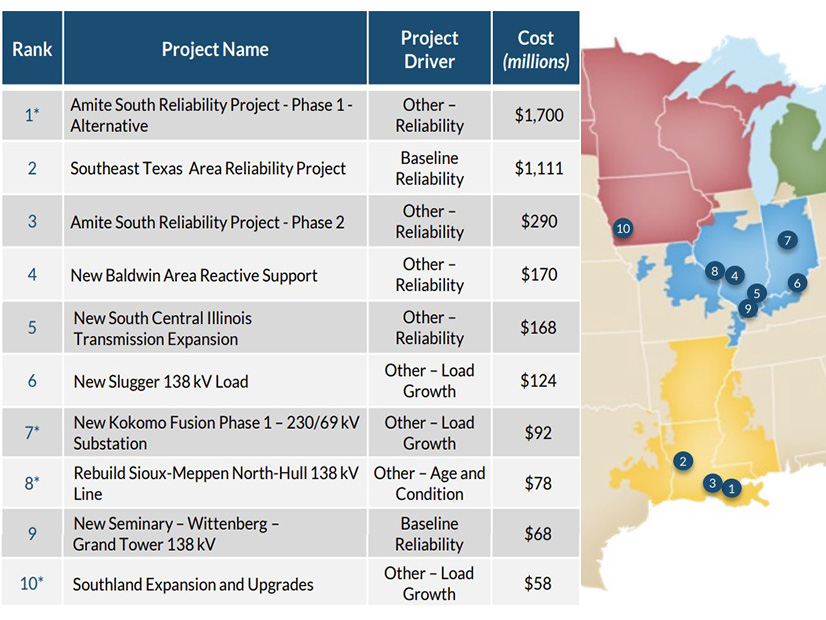MISO’s Planning Advisory Committee is deciding whether to approve the MISO 2023 Transmission Expansion Plan, which has dropped to just under $9 billion within a month.
Last month, MTEP 23 stood at 578 projects totaling $9.4 billion. Now the annual portfolio clocks in at $8.96 billion across 575 projects.
At a special Sept. 28 teleconference, the PAC opted for an email ballot through Oct. 5 on whether to recommend the portfolio to MISO board members. The PAC’s vote is advisory and can be bypassed.
MISO’s Jeremiah Doner said transmission owners have reviewed projects, made adjustments and refined cost estimates since the final round of subregional planning meetings on MTEP 23 in September.
Doner said some projects have been postponed to later MTEP cycles. Most notably, MISO has deferred the $260 million third phase of Entergy Louisiana’s Amite South reliability project into MTEP 24.
MISO is conducting additional analysis on possible alternatives to the project, which was among MTEP 23’s most expensive, Doner said.
Despite the deferral of the Entergy project, MISO South’s 77 projects still account for 46% of MTEP 23 spending. MISO remains committed to its recommended, $1.7 billion, 500-kV Commodore-Waterford-Churchill loop project, which will replace both the first phase of Entergy Louisiana’s Amite South project and the Downstream of Gypsy reliability project, another Entergy Louisiana proposal. (See MTEP 23 Catapults to $9.4B; MISO Replaces South Reliability Projects.)
MTEP 23 contains $1.2 billion in generator interconnection upgrades, $1.7 billion in baseline reliability projects and nearly $6 billion in “other” projects, which includes reliability projects based on transmission owners’ self-imposed criteria separate from NERC standards, such as projects responding to load growth or addressing the age and condition of existing facilities.
Doner said MISO is confident it has assembled a package of “efficient, cost-effective solutions to identified system issues.”
Sector Critiques
MISO’s Competitive Transmission Developers Sector said the RTO should have reviewed more projects for “more efficient or cost-effective regional project alternatives.”
“Such a review is required by the MISO tariff and FERC Order No. 1000, and the failure to consider alternatives may lead to the approval of transmission projects that do not efficiently solve these and other system needs, which ultimately increases costs to customers,” the developers said.
Doner responded that MISO already prioritized alternative analyses for proposed new lines and larger, expensive projects that may affect the entire system.
“Roughly 75% of MTEP 23 projects didn’t meet criteria for alternative solution analysis, as they address needs with no cost-effective alternatives,” he said.
The RTO’s Environmental Sector said the MTEP 23 report should mention MISO’s “struggles to manage” its 242-GW generator interconnection queue and should describe what resources it needs to complete studies on time.
Doner said MISO continues to work on its queue processing time. He also pointed out that MISO is sitting on 49 GW worth of new generation that’s on hold despite MISO having already studied it and signed off on interconnection. He said “limitations on new interconnections are due to factors outside of MISO’s control, such as construction delays and supply chain issues.”
The Environmental Sector also asked MISO to pay more attention to HVDC lines in MTEP reports and do more to explore the potential for battery storage in MISO’s future.
Doner said MISO agrees that HVDC lines could be necessary. He said MISO and stakeholders will discuss HVDC needs as part of the second portfolio under MISO’s long-range transmission planning.
Doner also said, “MISO will monitor market performance and interconnection processes for potential improvements as more storage is constructed.”
Sustainable FERC Project’s Natalie McIntire said though the Environmental Sector often provides substantial comments, MISO “rarely” changes or adds detail to its MTEP reports based on the sector’s suggestions.
MISO said it will publish the comments it received as an appendix to the MTEP 23 report.
MTEP 23 will enter its next review at an Oct. 17 meeting of the System Planning Committee of the MISO Board of Directors.
MTEP 24
Meanwhile, MISO transmission owners have already submitted project proposals for MTEP 24, which will use the RTO’s new, one-stop model manager. The model manager project aims for one system of record for all planning and operations models to eliminate redundant data entry and review.
MISO and vendor Siemens are working to synchronize data collection fields between MISO’s different model structures. At the Sept. 27 Planning Subcommittee, MISO’s Scott Goodwin said he expects a few hiccups as MISO transitions to the new model system for MTEP 24.


